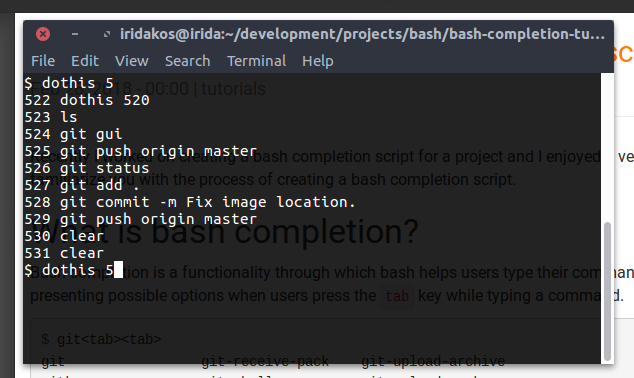I recently worked on creating a Bash completion script for a project, and I enjoyed it very much. In this post, I will try to familiarize you with the process of creating a Bash completion script.
What is Bash completion?
Bash completion is a functionality through which Bash helps users type their commands more quickly and easily. It does this by presenting possible options when users press the Tab key while typing a command.
$ git<tab><tab>
git git-receive-pack git-upload-archive
gitk git-shell git-upload-pack
$ git-s<tab>
$ git-shellHow it works
The completion script is code that uses the builtin Bash command complete to define which completion suggestions can be displayed for a given executable. The nature of the completion options vary, from simple static to highly sophisticated.
Why bother?
This functionality helps users by:
- saving them from typing text when it can be auto-completed
- helping them know the available continuations to their commands
- preventing errors and improving their experience by hiding or showing options based on what they have already typed
Hands-on
Here’s what we will do in this tutorial:
We will first create a dummy executable script called dothis. All it does is execute the command that resides on the number that was passed as an argument in the user’s history. For example, the following command will simply execute the ls -a command, given that it exists in history with number 235:
dothis 235Then we will create a Bash completion script that will display commands along with their number from the user’s history, and we will “bind” it to the dothis executable.
$ dothis <tab><tab>
215 ls
216 ls -la
217 cd ~
218 man history
219 git status
220 history | cut -c 8-

You can see a gif demonstrating the functionality at this tutorial’s code repository on GitHub.
Let the show begin.
Creating the executable script
Create a file named dothis in your working directory and add the following code:
if [ -z "$1" ]; then
echo "No command number passed"
exit 2
fi
exists=$(fc -l -1000 | grep ^$1 -- 2>/dev/null)
if [ -n "$exists" ]; then
fc -s -- "$1"
else
echo "Command with number $1 was not found in recent history"
exit 2
fiNotes:
- We first check if the script was called with an argument
- We then check if the specific number is included in the last 1000 commands
- if it exists, we execute the command using the
fcfunctionality - otherwise, we display an error message
- if it exists, we execute the command using the
Make the script executable with:
chmod +x ./dothisWe will execute this script many times in this tutorial, so I suggest you place it in a folder that is included in your path so that we can access it from anywhere by typing dothis.
I installed it in my home bin folder using:
install ./dothis ~/bin/dothisYou can do the same given that you have a ~/bin folder and it is included in your PATH variable.
Check to see if it’s working:
dothisYou should see this:
$ dothis
No command number passedDone.
Creating the completion script
Create a file named dothis-completion.bash. From now on, we will refer to this file with the term completion script.
Once we add some code to it, we will source it to allow the completion to take effect. We must source this file every single time we change something in it.
Later in this tutorial, we will discuss our options for registering this script whenever a Bash shell opens.
Static completion
Suppose that the dothis program supported a list of commands, for example:
nowtomorrownever
Let’s use the complete command to register this list for completion. To use the proper terminology, we say we use the complete command to define a completion specification (compspec) for our program.
Add this to the completion script.
#/usr/bin/env bash
complete -W "now tomorrow never" dothisHere's what we specified with the complete command above:
- we used the
-W(wordlist) option to provide a list of words for completion. - we defined to which “program” these completion words will be used (the
dothisparameter)
Source the file:
source ./dothis-completion.bashNow try pressing Tab twice in the command line, as shown below:
$ dothis <tab><tab>
never now tomorrowTry again after typing the n:
$ dothis n<tab><tab>
never nowMagic! The completion options are automatically filtered to match only those starting with n.
Note: The options are not displayed in the order that we defined them in the word list; they are automatically sorted.
There are many other options to be used instead of the -W that we used in this section. Most produce completions in a fixed manner, meaning that we don’t intervene dynamically to filter their output.
For example, if we want to have directory names as completion words for the dothis program, we would change the complete command to the following:
complete -A directory dothisPressing Tab after the dothis program would get us a list of the directories in the current directory from which we execute the script:
$ dothis <tab><tab>
dir1/ dir2/ dir3/Find the complete list of the available flags in the Bash Reference Manual.
Dynamic completion
We will be producing the completions of the dothis executable with the following logic:
- If the user presses the Tab key right after the command, we will show the last 50 executed commands along with their numbers in history
- If the user presses the Tab key after typing a number that matches more than one command from history, we will show only those commands along with their numbers in history
- If the user presses the Tab key after a number that matches exactly one command in history, we auto-complete the number without appending the command’s literal (if this is confusing, no worries—you will understand later)
Let’s start by defining a function that will execute each time the user requests completion on a dothis command. Change the completion script to this:
#/usr/bin/env bash
_dothis_completions()
{
COMPREPLY+=("now")
COMPREPLY+=("tomorrow")
COMPREPLY+=("never")
}
complete -F _dothis_completions dothisNote the following:
- we used the
-Fflag in the complete command defining that the_dothis_completionsis the function that will provide the completions of thedothisexecutable COMPREPLYis an array variable used to store the completions—the completion mechanism uses this variable to display its contents as completions
Now source the script and go for completion:
$ dothis <tab><tab>
never now tomorrowPerfect. We produce the same completions as in the previous section with the word list. Or not? Try this:
$ dothis nev<tab><tab>
never now tomorrowAs you can see, even though we type nev and then request for completion, the available options are always the same and nothing gets completed automatically. Why is this happening?
- The contents of the
COMPREPLYvariable are always displayed. The function is now responsible for adding/removing entries from there. - If the
COMPREPLYvariable had only one element, then that word would be automatically completed in the command. Since the current implementation always returns the same three words, this will not happen.
Enter compgen: a builtin command that generates completions supporting most of the options of the completecommand (ex. -W for word list, -d for directories) and filtering them based on what the user has already typed.
Don’t worry if you feel confused; everything will become clear later.
Type the following in the console to better understand what compgen does:
$ compgen -W "now tomorrow never"
now
tomorrow
never
$ compgen -W "now tomorrow never" n
now
never
$ compgen -W "now tomorrow never" t
tomorrowSo now we can use it, but we need to find a way to know what has been typed after the dothis command. We already have the way: The Bash completion facilities provide Bash variables related to the completion taking place. Here are the more important ones:
COMP_WORDS: an array of all the words typed after the name of the program thecompspecbelongs toCOMP_CWORD: an index of theCOMP_WORDSarray pointing to the word the current cursor is at—in other words, the index of the word the cursor was when the tab key was pressedCOMP_LINE: the current command line
To access the word just after the dothis word, we can use the value of COMP_WORDS[1]
Change the completion script again:
#/usr/bin/env bash
_dothis_completions()
{
COMPREPLY=($(compgen -W "now tomorrow never" "${COMP_WORDS[1]}"))
}
complete -F _dothis_completions dothisSource, and there you are:
$ dothis
never now tomorrow
$ dothis n
never nowNow, instead of the words now, tomorrow, never, we would like to see actual numbers from the command history.
The fc -l command followed by a negative number -n displays the last n commands. So we will use:
fc -l -50which lists the last 50 executed commands along with their numbers. The only manipulation we need to do is replace tabs with spaces to display them properly from the completion mechanism. sed to the rescue.
Change the completion script as follows:
#/usr/bin/env bash
_dothis_completions()
{
COMPREPLY=($(compgen -W "$(fc -l -50 | sed 's/\t//')" -- "${COMP_WORDS[1]}"))
}
complete -F _dothis_completions dothisSource and test in the console:
$ dothis <tab><tab>
632 source dothis-completion.bash 649 source dothis-completion.bash 666 cat ~/.bash_profile
633 clear 650 clear 667 cat ~/.bashrc
634 source dothis-completion.bash 651 source dothis-completion.bash 668 clear
635 source dothis-completion.bash 652 source dothis-completion.bash 669 install ./dothis ~/bin/dothis
636 clear 653 source dothis-completion.bash 670 dothis
637 source dothis-completion.bash 654 clear 671 dothis 6546545646
638 clear 655 dothis 654 672 clear
639 source dothis-completion.bash 656 dothis 631 673 dothis
640 source dothis-completion.bash 657 dothis 150 674 dothis 651
641 source dothis-completion.bash 658 dothis 675 source dothis-completion.bash
642 clear 659 clear 676 dothis 651
643 dothis 623 ls -la 660 dothis 677 dothis 659
644 clear 661 install ./dothis ~/bin/dothis 678 clear
645 source dothis-completion.bash 662 dothis 679 dothis 665
646 clear 663 install ./dothis ~/bin/dothis 680 clear
647 source dothis-completion.bash 664 dothis 681 clear
648 clear 665 cat ~/.bashrcNot bad.
We do have a problem, though. Try typing a number as you see it in your completion list and then press the key again.
$ dothis 623<tab>
$ dothis 623 ls 623 ls -la
...
$ dothis 623 ls 623 ls 623 ls 623 ls 623 ls -laThis is happening because in our completion script, we used the ${COMP_WORDS[1]} to always check the first typed word after the dothis command (the number 623 in the above snippet). Hence the completion continues to suggest the same completion again and again when the Tab key is pressed.
To fix this, we will not allow any kind of completion to take place if at least one argument has already been typed. We will add a condition in our function that checks the size of the aforementioned COMP_WORDS array.
#/usr/bin/env bash
_dothis_completions()
{
if [ "${#COMP_WORDS[@]}" != "2" ]; then
return
fi
COMPREPLY=($(compgen -W "$(fc -l -50 | sed 's/\t//')" -- "${COMP_WORDS[1]}"))
}
complete -F _dothis_completions dothisSource and retry.
$ dothis 623<tab>
$ dothis 623 ls -la<tab> # SUCCESS: nothing happens hereThere is another thing we don’t like, though. We do want to display the numbers along with the corresponding commands to help users decide which one is desired, but when there is only one completion suggestion and it gets automatically picked by the completion mechanism, we shouldn’t append the command literal too.
In other words, our dothis executable accepts only a number, and we haven’t added any functionality to check or expect other arguments. When our completion function gives only one result, we should trim the command literal and respond only with the command number.
To accomplish this, we will keep the response of the compgen command in an array variable, and if its size is 1, we will trim the one and only element to keep just the number. Otherwise, we’ll let the array as is.
Change the completion script to this:
#/usr/bin/env bash
_dothis_completions()
{
if [ "${#COMP_WORDS[@]}" != "2" ]; then
return
fi
# keep the suggestions in a local variable
local suggestions=($(compgen -W "$(fc -l -50 | sed 's/\t/ /')" -- "${COMP_WORDS[1]}"))
if [ "${#suggestions[@]}" == "1" ]; then
# if there's only one match, we remove the command literal
# to proceed with the automatic completion of the number
local number=$(echo ${suggestions[0]/%\ */})
COMPREPLY=("$number")
else
# more than one suggestions resolved,
# respond with the suggestions intact
COMPREPLY=("${suggestions[@]}")
fi
}
complete -F _dothis_completions dothisRegistering the completion script
If you want to enable the completion just for you on your machine, all you have to do is add a line in your .bashrc file sourcing the script:
source <path-to-your-script>/dothis-completion.bashIf you want to enable the completion for all users, you can just copy the script under /etc/bash_completion.d/ and it will automatically be loaded by Bash.
Fine-tuning the completion script
Here are some extra steps for better results:
Displaying each entry in a new line
In the Bash completion script I was working on, I too had to present suggestions consisting of two parts. I wanted to display the first part in the default color and the second part in gray to distinguish it as help text. In this tutorial’s example, it would be nice to present the numbers in the default color and the command literal in a less fancy one.
Unfortunately, this is not possible, at least for now, because the completions are displayed as plain text and color directives are not processed (for example: \e[34mBlue).
What we can do to improve the user experience (or not) is to display each entry in a new line. This solution is not that obvious since we can’t just append a new line character in each COMPREPLY entry. We will follow a rather hackish method and pad suggestion literals to a width that fills the terminal.
Enter printf. If you want to display each suggestion on each own line, change the completion script to the following:
#/usr/bin/env bash
_dothis_completions()
{
if [ "${#COMP_WORDS[@]}" != "2" ]; then
return
fi
local IFS=$'\n'
local suggestions=($(compgen -W "$(fc -l -50 | sed 's/\t//')" -- "${COMP_WORDS[1]}"))
if [ "${#suggestions[@]}" == "1" ]; then
local number="${suggestions[0]/%\ */}"
COMPREPLY=("$number")
else
for i in "${!suggestions[@]}"; do
suggestions[$i]="$(printf '%*s' "-$COLUMNS" "${suggestions[$i]}")"
done
COMPREPLY=("${suggestions[@]}")
fi
}
complete -F _dothis_completions dothisSource and test:
dothis <tab><tab>
...
499 source dothis-completion.bash
500 clear
...
503 dothis 500Customizable behavior
In our case, we hard-coded to display the last 50 commands for completion. This is not a good practice. We should first respect what each user might prefer. If he/she hasn’t made any preference, we should default to 50.
To accomplish that, we will check if an environment variable DOTHIS_COMPLETION_COMMANDS_NUMBER has been set.
Change the completion script one last time:
#/usr/bin/env bash
_dothis_completions()
{
if [ "${#COMP_WORDS[@]}" != "2" ]; then
return
fi
local commands_number=${DOTHIS_COMPLETION_COMMANDS_NUMBER:-50}
local IFS=$'\n'
local suggestions=($(compgen -W "$(fc -l -$commands_number | sed 's/\t//')" -- "${COMP_WORDS[1]}"))
if [ "${#suggestions[@]}" == "1" ]; then
local number="${suggestions[0]/%\ */}"
COMPREPLY=("$number")
else
for i in "${!suggestions[@]}"; do
suggestions[$i]="$(printf '%*s' "-$COLUMNS" "${suggestions[$i]}")"
done
COMPREPLY=("${suggestions[@]}")
fi
}
complete -F _dothis_completions dothisSource and test:
export DOTHIS_COMPLETION_COMMANDS_NUMBER=5
$ dothis <tab><tab>
505 clear
506 source ./dothis-completion.bash
507 dothis clear
508 clear
509 export DOTHIS_COMPLETION_COMMANDS_NUMBER=5Useful links
- Git’s completion script
- Bash Reference Manual: Programmable Completion
- Bash Reference Manual: Programmable Completion Builtins
- Bash Reference Manual: A Programmable Completion Example
- Bash Reference Manual: Bash Variables
Code and comments
You can find the code of this tutorial on GitHub.
For feedback, comments, typos, etc., please open an issue in the repository.
Long post, cat photo
Let me introduce you to my debugger:

That’s all, folks!
This post was originally posted at Iridakos.com. Reposted with permission.







7 Comments